Ever wondered how a simple change in wall color can transform the entire vibe of your bedroom? Wall color ideas are incredibly popular because they have the power to set the mood, enhance functionality, and reflect your personal style—all while making the space feel fresh and inviting. Whether you’re aiming for a calming retreat or a vibrant haven, the right hues can do wonders for your comfort and daily routine.
In this article, you’ll discover a variety of inspiring and practical wall color ideas tailored to maximize your bedroom’s functionality. From soothing neutrals to bold accent walls, each concept is designed to help you create a space that’s both beautiful and highly functional. Get ready to explore creative ways to define zones, boost natural light, and choose colors that match your lifestyle—your perfect bedroom makeover starts here!
1. Soft Neutrals to Create a Calm, Versatile Backdrop
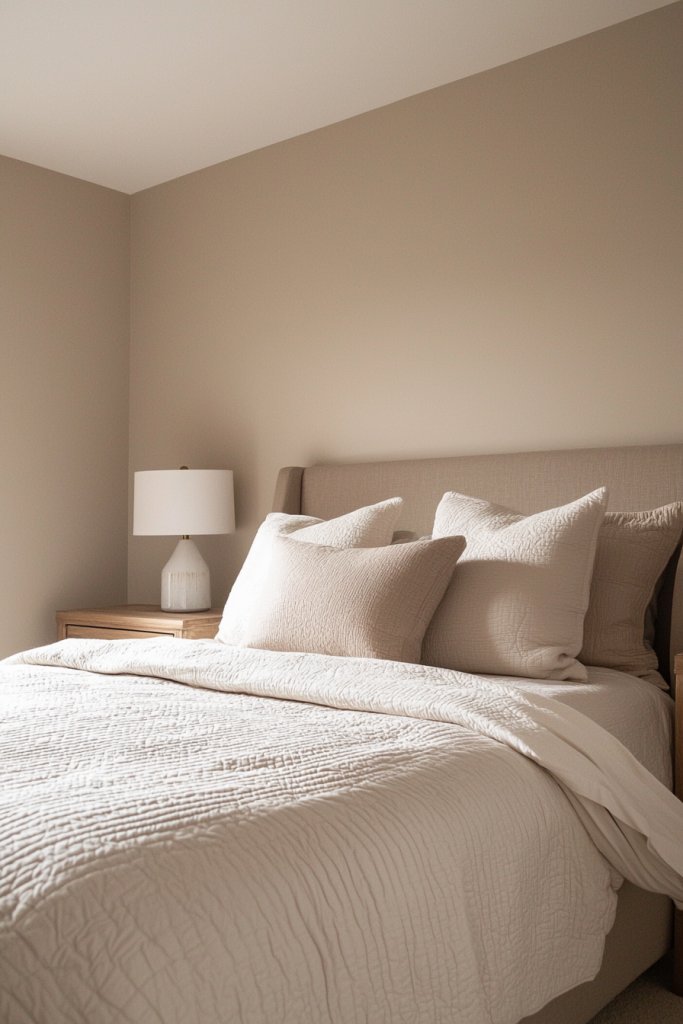
Creating a calming, versatile bedroom backdrop with soft neutrals is like giving your space a gentle hug—perfect for fostering relaxation and easy to update with your personal style. These understated hues set the stage for a peaceful retreat that feels both timeless and adaptable to any decor choice.
Imagine walls painted in warm beige or a subtle greige, their matte finish absorbing natural light and eliminating harsh reflections. The soft, muted tones create a smooth canvas where cozy textiles like a plush cream throw blanket with chunky knit texture or a velvety blush cushion add inviting layers.
The overall palette feels airy and serene, with hints of taupe and soft white blending seamlessly. You might also incorporate natural materials like woven baskets or ceramic lamps to enhance the organic, calming vibe—think quiet mornings and restful evenings in a space that whispers tranquility.
Getting started is easier than you might think: choose a high-quality matte paint in neutral shades like warm almond or light taupe, which are widely available at hardware stores. Use painter’s tape to achieve clean edges if you want a soft accent wall or keep it uniform for a seamless look.
Add soft textiles such as a plush rug or linen curtains in complementary tones to enhance comfort. If you prefer a touch of contrast, subtle accents like a textured ceramic vase or a woven wall hanging will elevate the space without disrupting the calm. With simple tools like brushes or rollers and a little patience, you can craft a serene backdrop that perfectly balances style and function.
2. Light Gray for a Modern, Reflective Space
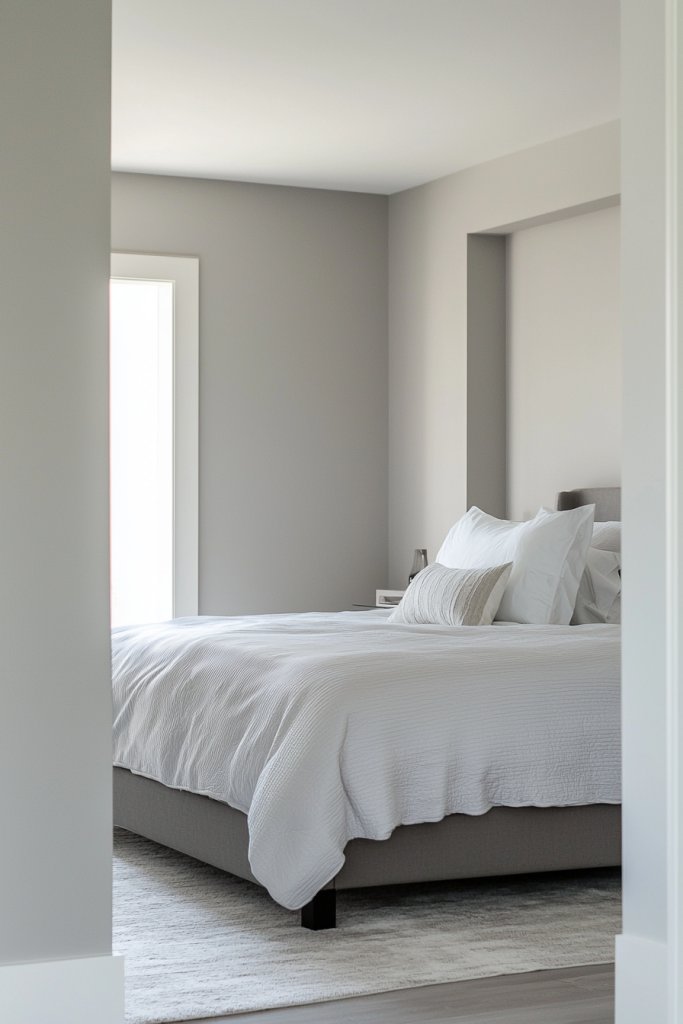
A light gray wall creates an instantly modern and calming atmosphere in any bedroom, serving as the perfect backdrop for both relaxation and functionality. Its reflective quality helps bounce natural light around the room, making the space feel larger, brighter, and more inviting.
Imagine a wall painted in a soft, cool gray with a matte finish that minimizes glare and adds a touch of understated elegance. The muted tone pairs beautifully with white or charcoal bedding, plush textiles like a cozy throw blanket in a gentle pastel hue, and sleek metallic accents such as brushed nickel lamps or picture frames.
The subtle texture of the matte paint adds depth without overwhelming the senses, while the neutral color palette allows for easy addition of colorful accessories or layered lighting to change the mood. The overall effect is a space that feels both contemporary and serene, encouraging restful sleep and effortless style.
To bring this look to life, start with high-quality matte gray paint, which can be found in many brands and shades—light gray options like Benjamin Moore’s “Gray Owl” or Sherwin-Williams’ “Repose Gray” work beautifully. Prepare the wall surface by cleaning and patching any imperfections, then use painter’s tape to create clean edges.
Apply two coats for even coverage, and consider adding a soft, plush rug in a coordinating tone to enhance comfort underfoot. For easy updates, incorporate layered lighting such as soft LED lamps or wall sconces, and finish with simple, elegant textiles like linen pillowcases or a chunky knit throw to complete the tranquil, reflective space.
3. Muted Pastels for a Subtle, Soothing Environment
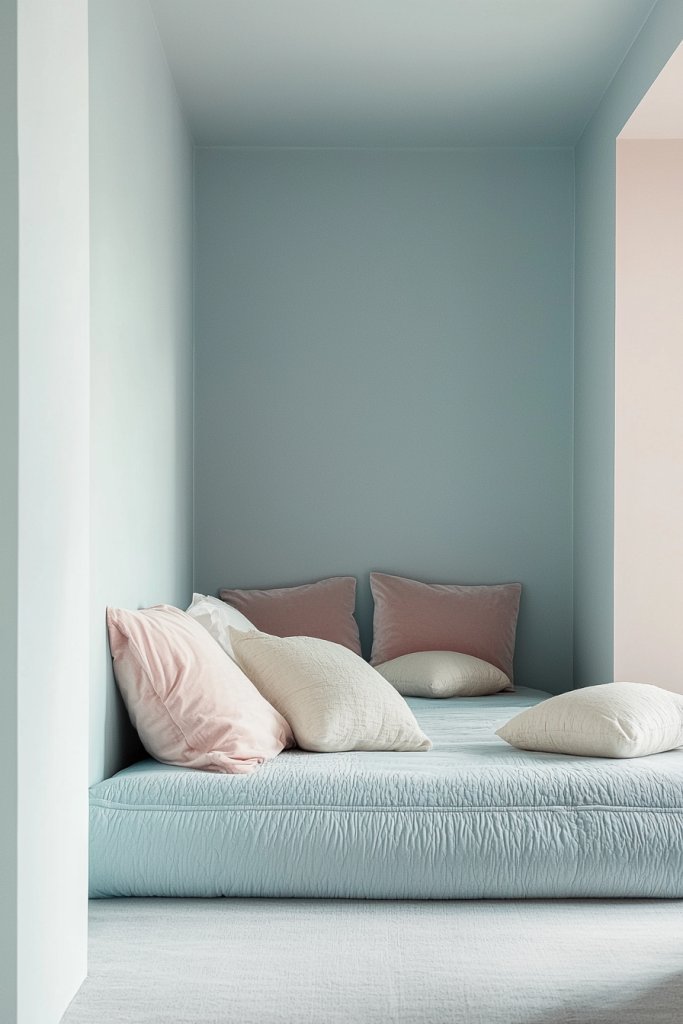
Embracing muted pastels in your bedroom creates a tranquil sanctuary that’s both stylish and incredibly calming. These soft hues help foster a peaceful environment, making it easier to unwind and recharge after a long day, all while maintaining a sophisticated, understated look.
Imagine walls painted in gentle shades like dusty pink, soft mint, or powder blue, with a matte finish that absorbs light rather than reflecting it. The colors are subtle yet inviting, providing a perfect backdrop for cozy textiles like a plush, cream-colored throw blanket with chunky knit texture or a silky, blush-colored bedspread.
Complementing these walls, you might include decorative accessories such as ceramic vases in muted tones, a woven jute rug underfoot, or a set of textured cushions in pastel shades that invite touch. The overall space feels airy and light, with a sensory harmony of soft textiles, gentle colors, and a quiet, soothing ambiance.
Getting started is simple: choose your favorite pastel shades—think of a muted lavender or a soft blush—and paint your walls in matte finish for a sophisticated look. Use painter’s tape for clean, crisp edges if you plan to add subtle accent stripes or borders.
To enhance the calming effect, incorporate soft textiles like a plush throw, silk pillowcases, or a linen bedspread, and select decorative objects in coordinating pastel hues. With just a few supplies—a quality matte paint, painter’s tape, and textiles—you can transform your bedroom into a serene pastel retreat that feels both peaceful and effortlessly stylish.
4. Deep, Rich Colors for Cozy, Defined Zones

Deep, rich colors can transform your bedroom into a cozy sanctuary with defined zones that invite relaxation and intimacy. Using bold, saturated hues creates a sense of warmth and enclosure, making each area feel purposeful and inviting.
Imagine walls painted in deep navy, espresso, or charcoal, their velvety finishes absorbing light and adding a luxurious depth to the space. These colors can be paired with plush textiles like a soft, cream throw blanket with chunky knit texture or a richly patterned area rug in warm tones.
You might add cozy elements such as velvet cushions or ceramic lamps with warm glow, which further enhance the sense of comfort. The overall effect is a layered, inviting environment where each zone feels intentionally crafted—perfect for unwinding or resting.
To recreate this look, start by choosing your favorite deep color—whether it’s a sophisticated navy or a warm chocolate brown—and select high-quality matte or eggshell paint for a smooth, non-reflective finish. Use painter’s tape to define your zones if you want to create a clearly delineated space, or simply paint an accent wall behind your bed for a striking focal point.
Pair your walls with soft textiles like velvet pillows, textured throws, or woven baskets for added warmth. If you prefer a less permanent option, consider removable wallpaper or fabric wall coverings in rich hues, making it easy to change your look over time. With these simple steps, you can craft a cozy, beautifully defined bedroom zone that feels both luxurious and welcoming.
5. Two-Tone Walls for Visual Interest and Zone Definition

Transforming your bedroom with two-tone walls is a clever way to add depth and define different zones without overcrowding the space. This technique not only enhances visual interest but also creates a more organized, functional environment that feels both stylish and purposeful.
Imagine a bedroom where the lower half of the walls is painted in a warm, earthy taupe, providing a cozy foundation, while the upper half is a soft, muted cream that reflects light beautifully. The transition between the two colors is often achieved with a crisp, clean line, perhaps accented with a subtle chair rail or decorative molding.
The textures of the paint can vary from matte to eggshell, adding a refined touch, and the contrast between the warm and neutral tones makes the space feel inviting yet distinctly divided. You might also incorporate plush textiles like a beige throw blanket with a chunky knit texture or a woven basket for storage, enhancing the tactile experience and reinforcing the layered, intentional look.
Getting started with this style is simple and budget-friendly. First, choose two complementary or contrasting colors—consider warm taupe paired with crisp white or soft gray with charcoal accents.
Use painter’s tape to mark off the boundary line, ensuring a straight, even separation, and then carefully apply your chosen paints with a quality brush or roller. If you want a more decorative touch, add a thin line of metallic or patterned wallpaper along the dividing line for extra flair. Finish by removing the tape once the paint is dry, and add your favorite textiles or decorative objects to emphasize the zones—think cozy reading corners or a dedicated dressing area—creating a layered, personalized space that’s both beautiful and highly functional.
6. Accent Walls with Bold Colors to Highlight Focal Points
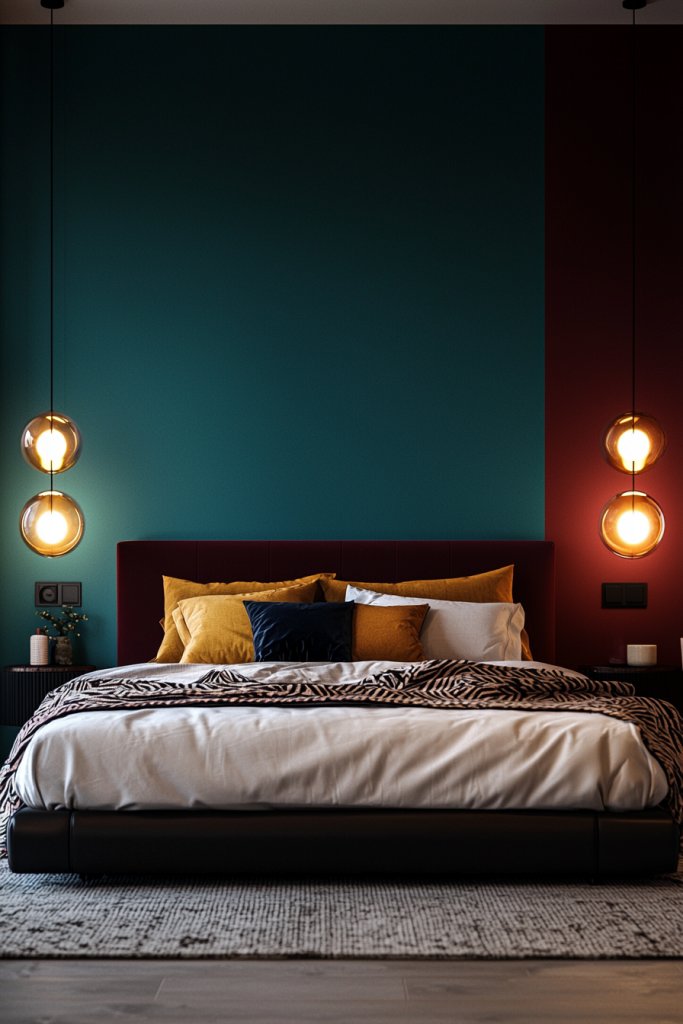
A bold accent wall instantly transforms a bedroom into a stylish, eye-catching retreat by emphasizing a key area of the space. This approach draws attention to architectural features or headboards, creating a visual anchor that anchors the entire room’s design.
It’s a clever way to add personality and depth without overwhelming the room with color. Imagine a deep emerald green wall behind a sleek, minimalist bed frame, or a vibrant terracotta hue that energizes a neutral space.
The textured surface of matte or eggshell finish paint adds subtle sophistication, while the contrast with softer bedding—like a plush beige duvet or a silky, pale pink throw—enhances the focal point. The bold color provides a striking backdrop for decorative lighting or statement lamps, making the entire room feel cohesive yet dynamic.
The overall effect is both calming and invigorating, depending on your chosen shade. To implement this, start by selecting a color that complements your existing decor—think navy, deep plum, or vibrant mustard.
Use painter’s tape to mark the designated wall and apply a high-quality primer if needed, especially for darker or brighter hues. Choose a matte or eggshell finish for a sophisticated, non-reflective look.
Use painter’s rollers or brushes for clean edges, and consider adding a clear protective topcoat for durability. This simple DIY project can be achieved in a weekend, providing a personalized, functional focal point that elevates your bedroom’s style.
7. Warm Earth Tones for a Welcoming, Grounded Feel

Warm earth tones evoke a cozy, inviting atmosphere that makes a bedroom feel like a true sanctuary. Shades like terracotta, rust, ochre, or warm beige create a soothing backdrop that fosters relaxation, while also complementing a variety of furniture styles—from rustic wood to modern minimalism.
These hues are perfect for establishing a grounded, comfortable environment that encourages rest and rejuvenation. Picture walls painted in a soft terracotta, with subtle variations in tone that mimic the natural textures of clay or sandstone.
The warm palette pairs beautifully with natural textiles—like a chunky knit throw in cream or a linen duvet in sandy tones—and rustic wooden furniture. The space might smell subtly of earth and natural fibers, adding to the sensory richness.
Textural accents, such as woven baskets or ceramic lamps, enhance the tactile appeal of the room, making it feel layered and thoughtfully curated. Getting started is simple: select a warm, earthy hue from a reputable paint brand, such as Sherwin-Williams’ “Cavern Clay” or Benjamin Moore’s “Oatmeal.” Prepare your walls by cleaning and priming if necessary, then apply two coats of your chosen color using a roller for even coverage.
Finish with a semi-gloss or matte finish, depending on your preference. Pair the painted walls with warm-toned accessories and textiles to create a cohesive, welcoming space that feels both stylish and functional.
8. Cool Blues and Greens to Enhance Restorative Sleep
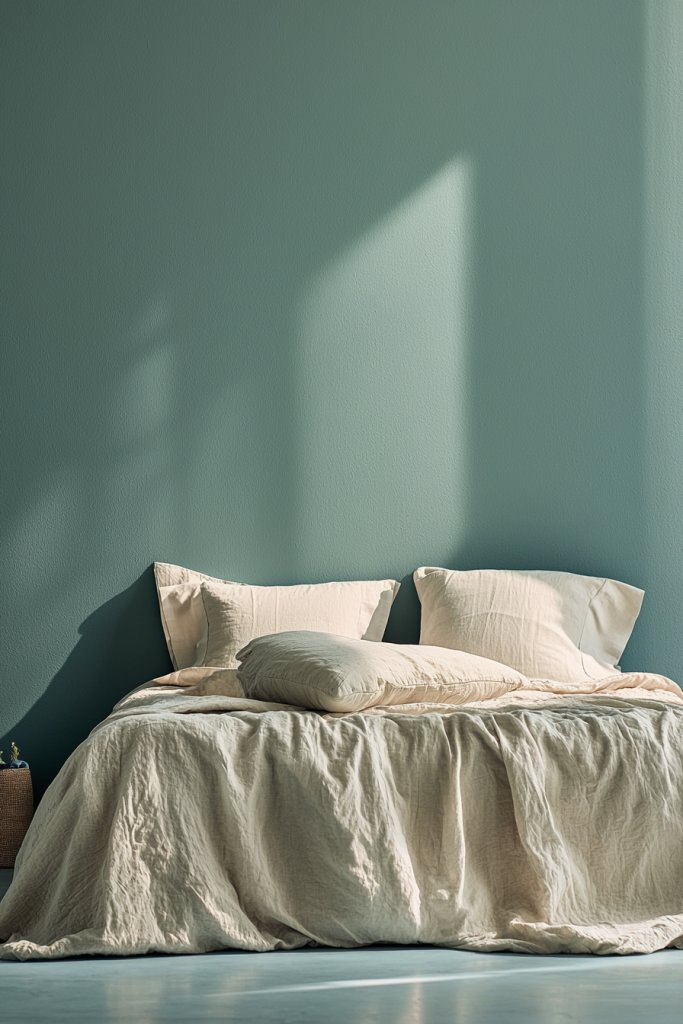
Cool blues and greens are renowned for their calming effects, making them ideal choices for a bedroom designed for restorative sleep. These tranquil shades evoke a sense of peace, helping to lower stress levels and promote relaxation.
Whether you opt for a soft seafoam, gentle mint, or calming navy, these colors contribute to a soothing environment that encourages restful nights. Visualize walls painted in a muted sage green, accented with crisp white trim and complemented by soft, plush bedding in shades of pale blue or mint.
The room feels refreshing and airy, almost like a gentle breeze flowing through the space. The colors subtly reflect natural elements—water, sky, foliage—creating a connection to nature that enhances tranquility.
Soft lighting, like warm LED bulbs or candles, further amplifies the calming vibe, making the bedroom a true sanctuary for rest. To achieve this look, choose a calming color palette with low-saturation shades, and opt for paint finishes like matte or eggshell to minimize glare.
Use painter’s tape for clean lines, and apply at least two coats of your chosen color to ensure even coverage. Pair the painted walls with light-colored textiles—think linen or cotton—and incorporate tactile textures like a fuzzy throw or velvet cushions. This approach results in a peaceful, functional space perfect for unwinding and sleeping soundly.
9. Matte Finishes for Reduced Glare and Sophisticated Look

Matte paint finishes offer a sleek, sophisticated aesthetic while providing practical benefits that enhance bedroom functionality. Unlike glossy or satin finishes, matte surfaces diffuse light, reducing glare and fingerprints, which makes maintenance easier and keeps the walls looking pristine over time.
This subtle, velvety look is perfect for creating a calm, elegant atmosphere. Imagine walls with a rich, velvety matte finish in a deep navy or soft blush, absorbing light rather than reflecting it.
This finish creates a plush, inviting backdrop that pairs beautifully with both modern and traditional decor. The tactile quality of matte paint adds depth and richness to the space, making the room feel more refined and cozy.
When paired with layered lighting—such as bedside lamps or dimmable sconces—the matte surface enhances the room’s ambiance, allowing you to customize the mood effortlessly. Applying a matte finish is straightforward: select a high-quality interior matte paint, and prepare the walls by cleaning and repairing any imperfections.
Use a roller for smooth, even coverage, and apply at least two coats for consistent color. Consider using a primer for darker or bold shades to prevent bleed-through. This finish is especially suitable for bedrooms, giving the space a sophisticated look that balances aesthetics with practicality, making it a smart choice for a functional, stylish sanctuary.
10. Two-Tone Ceiling and Wall Color Combinations

Using contrasting or complementary colors on the ceiling and walls is a creative way to add visual interest and define space effectively. This technique can make a room feel taller or cozier, depending on the color choices and placement.
It’s an excellent strategy for maximizing the perceived size of a bedroom while adding a personalized touch. Visualize a bedroom with soft, muted gray walls contrasted by a crisp white ceiling, creating a fresh, airy feel.
Alternatively, a deep navy ceiling paired with lighter wall shades like beige or blush can draw the eye upward, making the room seem more spacious and lofty. The contrast not only highlights architectural details but also adds a layer of sophistication and depth to the overall decor.
Strategically choosing colors based on the room’s lighting and size ensures a balanced, inviting environment that feels carefully curated yet comfortable. To implement this, start by selecting a main wall color and a ceiling shade that complement or contrast harmoniously.
Paint the ceiling first to avoid drips on the walls, then tape along the edges for clean lines. Use high-quality ceiling paint for smooth application, and finish with two coats for durability.
Keep the edges sharp and neat with painter’s tape, and consider adding subtle decorative molding or trim to enhance the two-tone effect. This approach transforms a simple ceiling into a design feature, adding personality and function to your bedroom space.
11. Light, Reflective Colors for Better Natural Light Utilization

Maximizing natural light in a bedroom can dramatically boost its functionality and mood, and choosing the right wall color is a key part of that process. Light, reflective hues make a space feel brighter, larger, and more welcoming—perfect for creating a versatile environment that adapts to your daily needs.
Imagine walking into a bedroom painted in soft, airy shades like pale beige, crisp white with warm undertones, or gentle dove gray. These colors bounce sunlight around the room, making it feel open and uplifting without overwhelming the senses.
The walls serve as a subtle backdrop for your furniture and decor, allowing natural light to create a warm glow that shifts throughout the day. This visual brightness enhances the overall sense of space, making even smaller rooms feel more expansive and inviting.
To recreate this effect, start by selecting colors such as Benjamin Moore’s Simply White, Sherwin-Williams’ Alabaster, or Farrow & Ball’s Wimborne White. Use matte or eggshell finishes to reduce glare and keep the surfaces smooth and soft.
Pair the walls with light-colored bedding, curtains, and furniture to reflect light further. Keep window treatments minimal—sheer curtains or light blinds will allow maximum daylight to fill the room. These simple choices will help you craft a bright, functional bedroom that feels open and energizing.
12. Neutral with Subtle Patterned Wall Colors for Visual Texture

Adding subtle patterns or textures to neutral wall colors can transform a bedroom into a space rich in depth and visual interest, all while maintaining a calming, versatile aesthetic. This approach enhances the room’s character without overwhelming its sense of serenity and functionality.
Picture walls painted in warm, muted tones like soft taupe or gentle greige, with delicate textured finishes such as a subtle linen or plaster effect. Lightly patterned wallpaper in tone-on-tone shades or textured paints can create an understated tactile experience—think a whisper of raised geometric shapes or a faintly embossed floral motif that catches the light differently throughout the day.
These visual textures add depth and warmth, inviting touch and eye movement without cluttering the space. The overall effect is a sophisticated, layered look that complements many decor styles, from minimalist to boho chic.
To achieve this look, choose neutral hues like Benjamin Moore’s Revere Pewter or Behr’s Silver Drop, then add a textured finish using specialty paints or wallpaper with subtle patterns. Applying a light skim coat or using textured wallpaper is straightforward and forgiving for DIYers.
Use a roller or brush to add gentle strokes or patterns, ensuring the texture remains subtle. Incorporate soft textiles, such as a plush throw or textured cushions, to further enhance tactile richness. This approach creates a cozy, elegant backdrop that elevates your bedroom’s style and functionality simultaneously.
13. Warm White for a Bright, Clean Canvas

A warm white wall color offers the perfect blank canvas for creating a bright, airy bedroom that adapts effortlessly to changing styles and seasons. It’s a classic choice that balances neutrality with a touch of coziness, making the space feel inviting yet versatile.
Visualize walls painted in a soft, creamy white with warm undertones—like Benjamin Moore’s White Dove or Sherwin-Williams’ Almond White. These hues reflect natural light beautifully, making the room feel open and fresh.
The warm white backdrop enhances the appearance of your furniture and textiles, allowing colorful or textured elements to stand out without competing. The overall ambiance feels clean and streamlined, yet comfortably welcoming for everyday living or special occasions.
To implement, pick a high-quality, matte or eggshell finish to reduce glare and create a smooth surface. Pair this with light-colored bedding, such as a plush beige or blush throw, and natural wood accents to amplify the warmth.
Minimalist accessories like woven baskets, ceramic vases, or soft textiles can add subtle texture and personality. This simple yet effective palette makes your bedroom adaptable, easy to update with new decor, and perfect for maximizing both daytime brightness and restful evenings.
14. Dark Accent Colors for Depth and Visual Anchoring
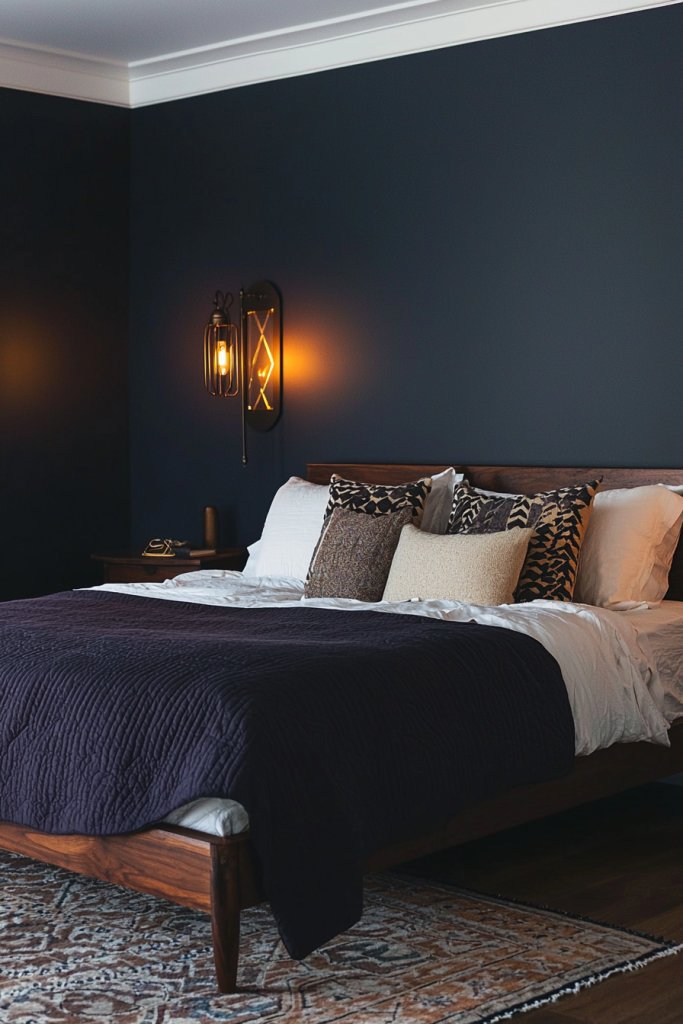
Using dark accent colors on one wall or specific sections of your bedroom can add depth, create a focal point, and anchor the space visually—an essential tool for defining zones and enhancing overall functionality. Imagine a deep navy or charcoal accent wall behind your bed, contrasting sharply with lighter furniture and bedding.
The rich hue creates a sense of intimacy and drama, drawing the eye inward and giving the room a grounded, sophisticated feel. When paired with lighter or neutral furnishings—such as white linens, light wood furniture, or metallic accents—the dark color provides a striking visual anchor that adds dimension without overwhelming the room.
To achieve this look, select a durable, matte or eggshell finish in shades like Farrow & Ball’s Hague Blue or Sherwin-Williams’ Iron Ore. Use painter’s tape and level to ensure crisp, clean lines if creating a defined accent wall.
For a more subtle effect, incorporate dark hues on smaller sections, such as a panel behind the headboard or framing a niche. Complement the look with soft lighting—warm or dimmable fixtures—to soften the intensity. This method introduces sophisticated contrast, making your bedroom more visually interesting while serving functional purposes like emphasizing sleeping zones or reading corners.
15. Color Blocking to Define Different Functional Areas

Color blocking is an innovative way to visually separate different zones within a bedroom, such as sleeping, dressing, or workspace areas, without adding physical dividers. It’s a practical solution to maximize space and enhance functionality while keeping the aesthetic engaging.
Picture a room where the sleeping area features a soothing pastel blue on one wall, while the dressing zone is highlighted with a soft beige or light gray. Sharp, clean lines delineate these sections, often done with painter’s tape for precision.
The contrasting colors create clear visual boundaries, guiding the eye naturally and helping the space feel organized and purposeful. This technique is especially useful in studio bedrooms or multifunctional spaces, where defining zones enhances usability and comfort.
To implement, choose two or three harmonious colors—like calming blues, gentle greens, or warm earth tones—and use painter’s tape to create geometric shapes or horizontal/vertical divisions. Apply high-quality interior paint, opting for matte or eggshell finishes to avoid glare and keep lines crisp.
Keep accessories minimal in each zone to reinforce the separation and maintain a clutter-free atmosphere. Color blocking offers a creative, budget-friendly way to enhance your bedroom’s functionality through thoughtful color choices and simple painterly techniques.
16. Two-Tone Vertical Stripes for Increased Perceived Height
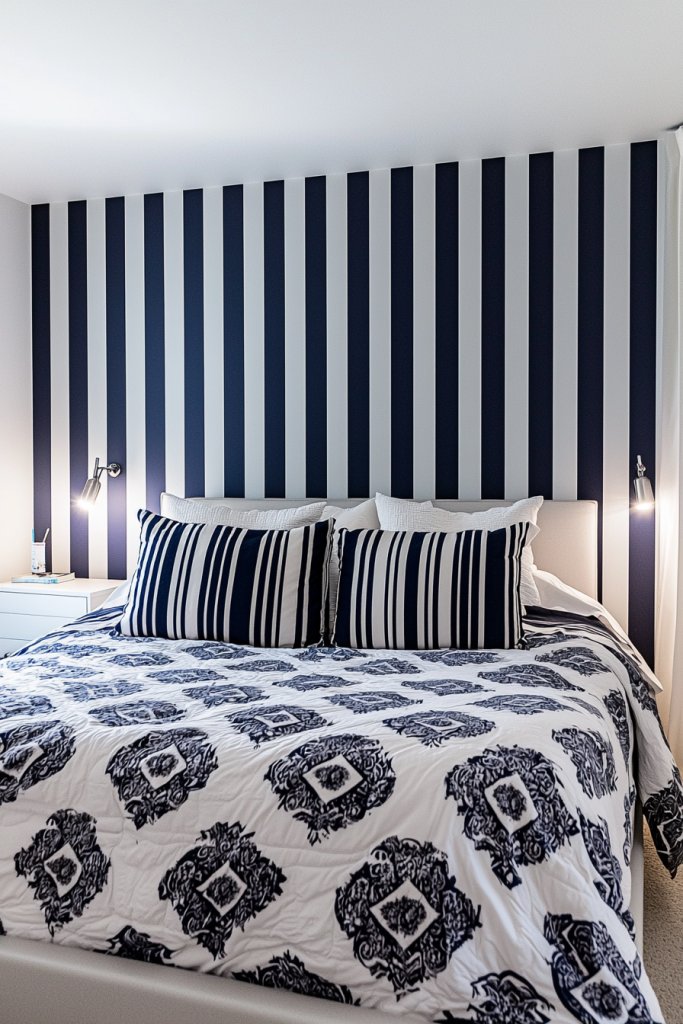
Creating the illusion of a taller ceiling or a more spacious room can be easily achieved with vertical stripes in two contrasting or complementary colors. This technique not only adds visual interest but also makes the room feel more open and airy.
Think of a combination like soft white paired with deep navy or light gray with charcoal—these choices can dramatically change how your space feels. The stripes can run from floor to ceiling, emphasizing height, or be confined to a portion of the wall for a more subtle effect.
The tactile contrast between matte and semi-gloss finishes can also enhance the visual depth, adding a tactile dimension to the design. Imagine walking into a bedroom where the walls are painted with crisp, vertical stripes—perhaps a pale blush and a warm taupe—drawing your eye upward and giving the impression of soaring ceilings.
The texture of the paint can be smooth or subtly textured, adding a tactile layer that invites touch. These stripes work well in both modern and traditional settings, especially when paired with simple, streamlined furniture that keeps the focus on the wall pattern.
Properly spaced, evenly painted stripes create a clean, cohesive look that elevates the entire room’s aesthetic. Getting started is straightforward: gather painter’s tape, a roller, and high-quality wall paint in your chosen shades.
Begin by measuring and marking equally spaced lines on the wall, then tape off each section carefully to ensure crisp edges. Use a primer if needed to ensure the contrast pops and colors stay vibrant.
For a more budget-friendly option, you can substitute wall decals with a similar striped pattern. With patience and steady hands, you’ll have a stunning visual upgrade that makes your bedroom feel taller and more spacious in no time.
17. Warm-Toned Walls Paired with Cool Textiles for Balance
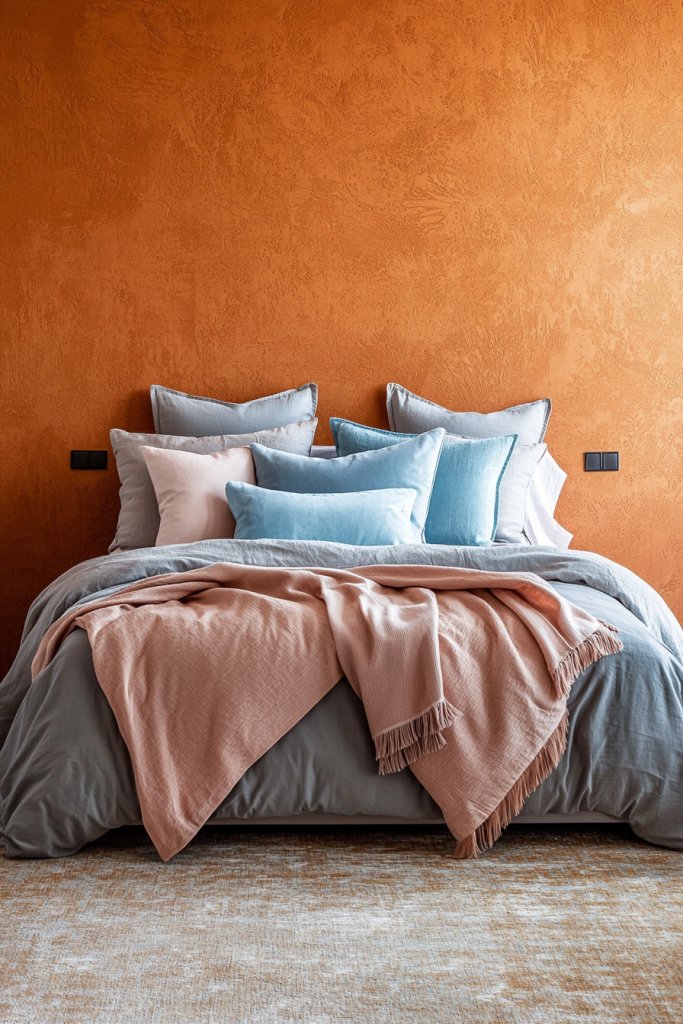
Warm wall colors like terracotta, rust, or ochre create an inviting, cozy atmosphere that feels both grounded and welcoming. When paired with cool-toned textiles—such as a soft blush throw blanket, mint-green pillows, or icy blue curtains—the overall aesthetic achieves a balanced, harmonious vibe.
This combination is perfect for creating a bedroom that feels warm and comfortable but also crisp and fresh. The contrast between the warm walls and cool textiles enhances spatial perception, making the room feel simultaneously snug and expansive.
Visualize a bedroom with warm, earthy-colored walls that evoke feelings of safety and comfort. Soft, plush textiles—like a chunky knit blanket in icy blue, smooth velvet cushions in mint, or a sleek, cool-toned area rug—add tactile contrast and visual interest.
The cool textiles provide a refreshing counterpoint that keeps the space from feeling too heavy, while the warm walls anchor the design in a cozy, inviting way. The lighting can be warm or cool depending on your mood, emphasizing the balance between these two color temperatures, and creating a space that is both soothing and energizing.
To recreate this look, start by choosing a warm wall color, such as terracotta or ochre, and paint your walls with a quality interior paint—matte or eggshell finish works well for a soft, inviting look. Add textiles like a soft blush throw blanket, mint-colored cushions, or cool-toned curtains made from breathable fabrics like linen or cotton.
Incorporate accessories in neutral tones to keep the look cohesive. This balanced approach ensures your bedroom feels inviting yet fresh, perfect for relaxing or sleeping.
18. Monochromatic Color Schemes for Cohesion and Simplicity
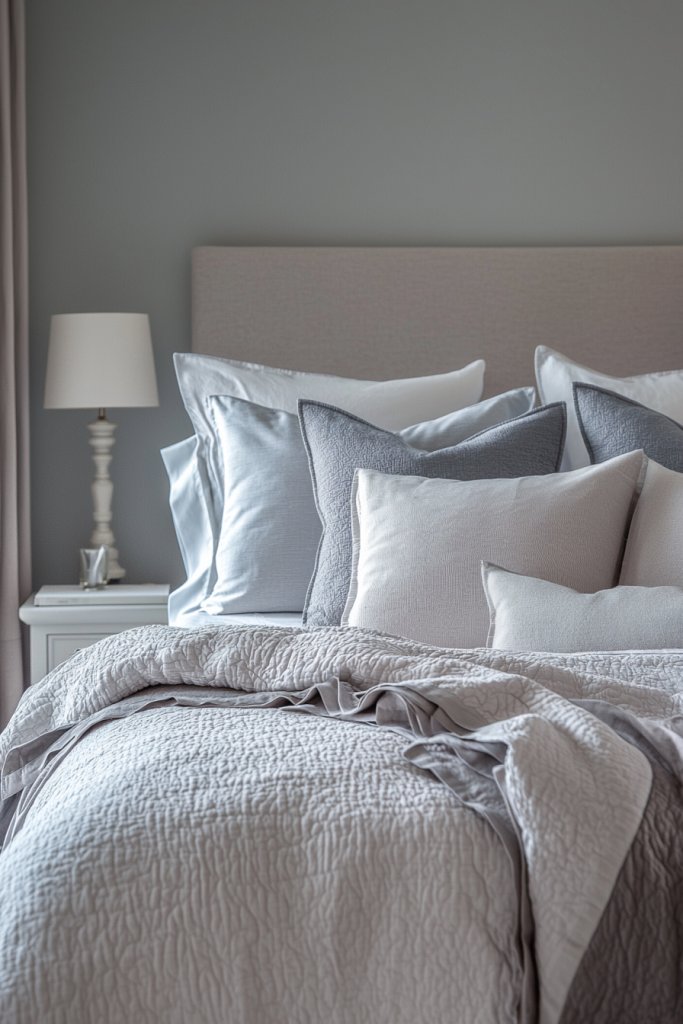
Sticking to a monochromatic color palette—using various shades and tints of a single hue—creates a serene, cohesive bedroom environment that exudes calm and order. This approach simplifies decorating decisions and allows you to play with texture and light rather than color.
For example, layering different shades of blue from navy to pale sky, or mixing warm beige tones from taupe to cream, adds depth without visual chaos. The result is a sophisticated, uncluttered space that feels both intentional and relaxing.
Picture a bedroom where the walls are painted in a soft, muted sage green, complemented by bedding in darker olive and lighter mint accents. Textured elements like a chunky knit throw, woven baskets, or a plush rug in varying shades add tactile interest that keeps the monochromatic scheme lively.
The overall look is peaceful, with subtle shifts in tone providing visual variety. This design works well in small spaces, making them feel larger and more organized, and it’s easy to change or update by switching out accessories without repainting.
Begin by choosing your base color—perhaps a neutral or favorite hue—and select several shades and tints to create your palette. Use high-quality paint for the walls, and incorporate textiles, decorative pillows, and curtains in different shades of the same color family.
Keep accessories minimal and in harmony with the palette to maintain a clean, cohesive look. This strategy makes your bedroom adaptable and easy to refresh over time, offering a timeless, elegant aesthetic that’s both simple and highly functional.
19. Two-Tone Wainscoting and Wall Color for Practical Protection

Combining two-tone wainscoting with a complementary wall color offers both durability and style, especially in high-traffic or easily scuffed areas. Wainscoting protects the lower portion of the wall from everyday wear, while the contrasting color adds a chic, architectural detail.
For example, a crisp white wainscoting paired with soft gray or pastel walls creates a classic, sophisticated look. This approach not only enhances the room’s aesthetic but also makes cleaning and maintenance easier, contributing to a more functional space.
Visualize a bedroom with elegant white wainscoting framing the lower walls, topped with a soothing, muted blue or blush color on the upper walls. The textured paneling adds depth and dimension, while the contrasting colors define the space visually.
The wainscoting also provides a convenient surface for mounting artwork or decorative objects, and the two-tone effect draws the eye upward, making the room seem taller. Combining materials like wood, MDF, or PVC for the wainscoting ensures durability and ease of installation.
To implement this look, measure your wall height to determine the height of the wainscoting panels, then choose a durable material suited to your budget and skills. Paint the panels with semi-gloss or satin finishes for easy cleaning, and select wall colors that complement your overall decor.
Installing wainscoting is straightforward with basic tools—just cut, paint, and secure panels with adhesive or nails. This practical yet stylish feature enhances your bedroom’s longevity and visual appeal, making it both functional and fashionable.
20. Darker Walls with Light Furniture for Contrast and Clarity
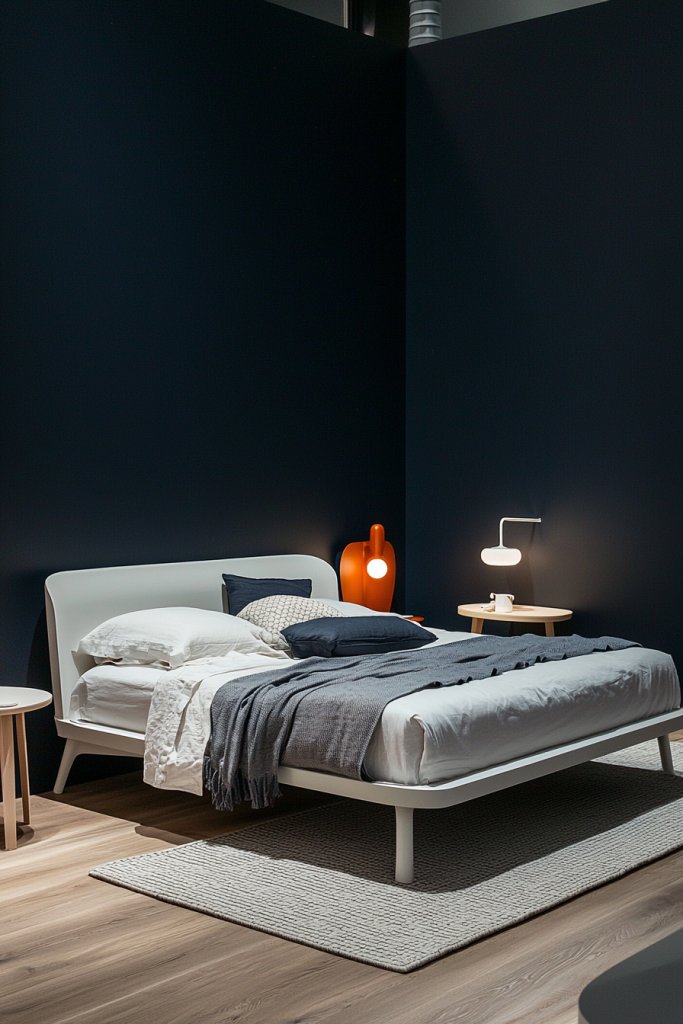
Creating a bedroom with darker walls paired with light furniture offers a striking visual contrast that enhances both style and function. This approach makes the space feel sophisticated and grounded, while also ensuring that the room remains bright and inviting.
The dark walls—think deep charcoal, navy, or espresso—serve as a dramatic backdrop that anchors the room, while the light furniture, such as creamy white or pale wood pieces, keeps the space from feeling heavy or closed in. This combination not only visually clarifies the space but also helps highlight your furniture and decor elements, making daily routines easier and more enjoyable.
Imagine entering a bedroom where the walls are painted in a rich, velvety charcoal hue. The bed features a crisp white headboard, complemented by soft, neutral bedding with plush textures like a fluffy duvet or a chunky knit throw in light shades.
The contrast makes each piece stand out vividly, and the overall atmosphere feels both cozy and polished. The subtle interplay of dark and light tones creates a sense of depth and clarity, helping you easily locate essentials and keep the room visually organized.
The tactile contrast between the smooth painted walls and the soft textiles adds sensory richness, making the space both functional and inviting. To achieve this look, start by choosing a dark wall color such as charcoal or navy, using high-quality matte or eggshell finish paint for a sleek look.
Pair it with light-colored furniture—think a white nightstand, pale wood bed frame, or cream-colored dresser. For easy DIY, use painter’s tape to create clean, straight lines for accent walls or full coverage for all walls.
Opt for furniture in light finishes or painted in soft neutral tones, and incorporate light-colored bedding and accessories like a beige rug or pillows. These simple steps will transform your bedroom into a balanced, high-contrast sanctuary that’s both stylish and highly functional.
21. Neutral Walls with Strategic Lighting for Flexibility

Using neutral wall colors combined with layered lighting offers a versatile foundation that allows you to easily adapt your bedroom’s mood and functionality. Neutral tones—such as warm beige, soft taupe, or light greige—serve as a calming backdrop that works with any decor style.
When paired with smart lighting options, you can effortlessly shift from bright, energizing mornings to cozy, relaxing evenings, making this approach ideal for a multifunctional space that evolves with your needs. Picture a bedroom with walls painted in a warm, inviting beige.
Overhead, a dimmable ceiling fixture provides general illumination, while bedside lamps with adjustable brightness add task lighting for reading or working. A tall floor lamp or wall sconces with warm bulbs can create a soothing ambiance, perfect for winding down.
Incorporate layered lighting—such as LED strip lights behind headboards or under furniture—to add flexibility and depth. These lighting layers, combined with the neutral backdrop, make it easy to change the room’s atmosphere, whether you want vibrant energy or peaceful calm.
Implementing this idea is straightforward. Start by painting your walls in a neutral tone that complements your existing furniture and decor.
Choose lighting fixtures that offer dimming or multiple brightness settings—think bedside lamps, pendant lights, or smart LED strips. Use warm white bulbs for a cozy feel, or cool white for a more energizing vibe.
Position your lighting thoughtfully around the room to allow for different configurations, making it simple to switch from a bright workspace to a soft, relaxing retreat. This flexible setup creates a highly functional bedroom that adapts seamlessly to your lifestyle.
22. Custom Color Combinations for Personalized, Functional Design
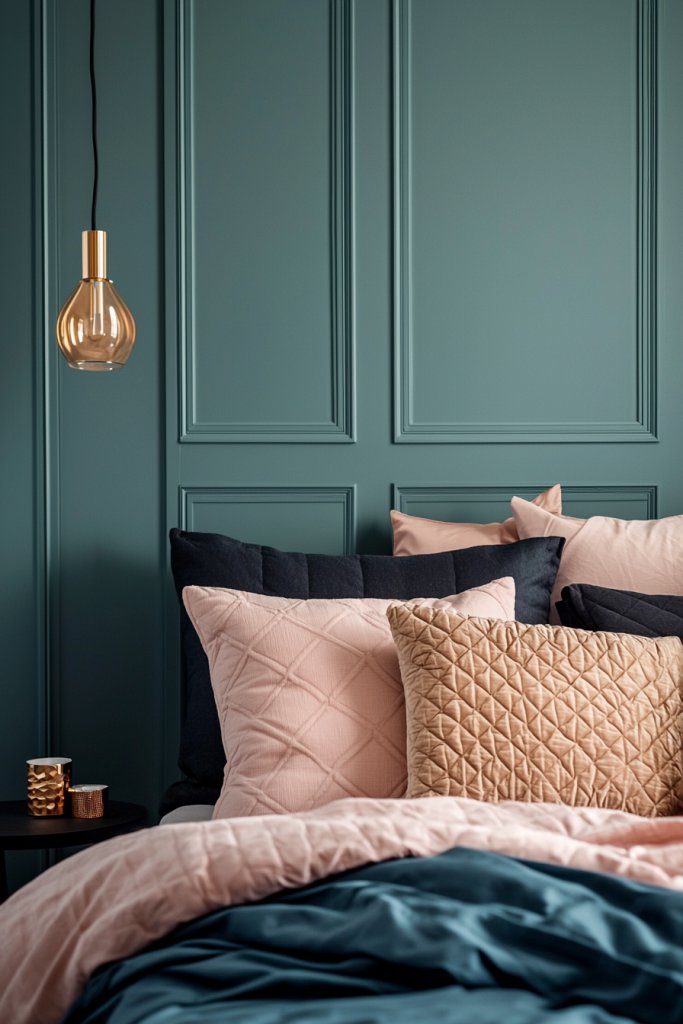
Designing a bedroom with personalized color combinations allows you to craft a space that truly reflects your personality and meets your practical needs. By thoughtfully blending colors that resonate with you—whether calming pastels, bold accents, or harmonious monochromes—you create an environment that is both aesthetically pleasing and highly functional.
Custom palettes can help define zones, boost mood, and streamline decor choices, making your bedroom uniquely yours. Visualize a bedroom where the walls feature a harmonious blend of soft blush pink and warm taupe, creating a gentle, inviting atmosphere.
Accent areas, like a reading nook or dressing zone, might incorporate deeper shades like navy or emerald for visual interest. Textures such as plush upholstery, silky curtains, or textured rugs can tie the colors together, enhancing the sensory experience.
Personal touches like cozy throws or decorative pillows in coordinating hues reinforce your chosen palette, making the space feel cohesive. The combination of colors encourages both relaxation and practicality, supporting different activities effortlessly.
Start by selecting a base color that suits your mood—light blues for calm, earthy greens for grounding, or neutral tones for versatility. Then, add accent shades that complement or contrast for visual interest, such as coral or mustard yellow.
Use these colors on walls, textiles, or decorative accessories to create harmony. Don’t forget to consider lighting; choosing warm or cool bulbs can change how colors appear and influence the room’s mood. With a bit of planning, your personalized color scheme will foster a space that balances aesthetic appeal with everyday functionality, making your bedroom a true reflection of your lifestyle.
Conclusion
With so many creative wall color ideas—from soft neutrals and calming pastels to bold accents and innovative techniques—there’s a perfect option to enhance both the style and functionality of any bedroom. Whether you prefer soothing hues that promote rest or striking contrasts that define zones, these ideas empower you to transform your space into a personalized sanctuary.
Don’t hesitate to experiment and make your bedroom truly your own. Start exploring these ideas today and create a functional, beautiful retreat that reflects your unique style!
Leave a Reply